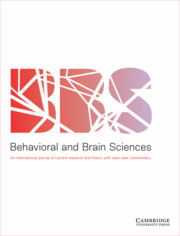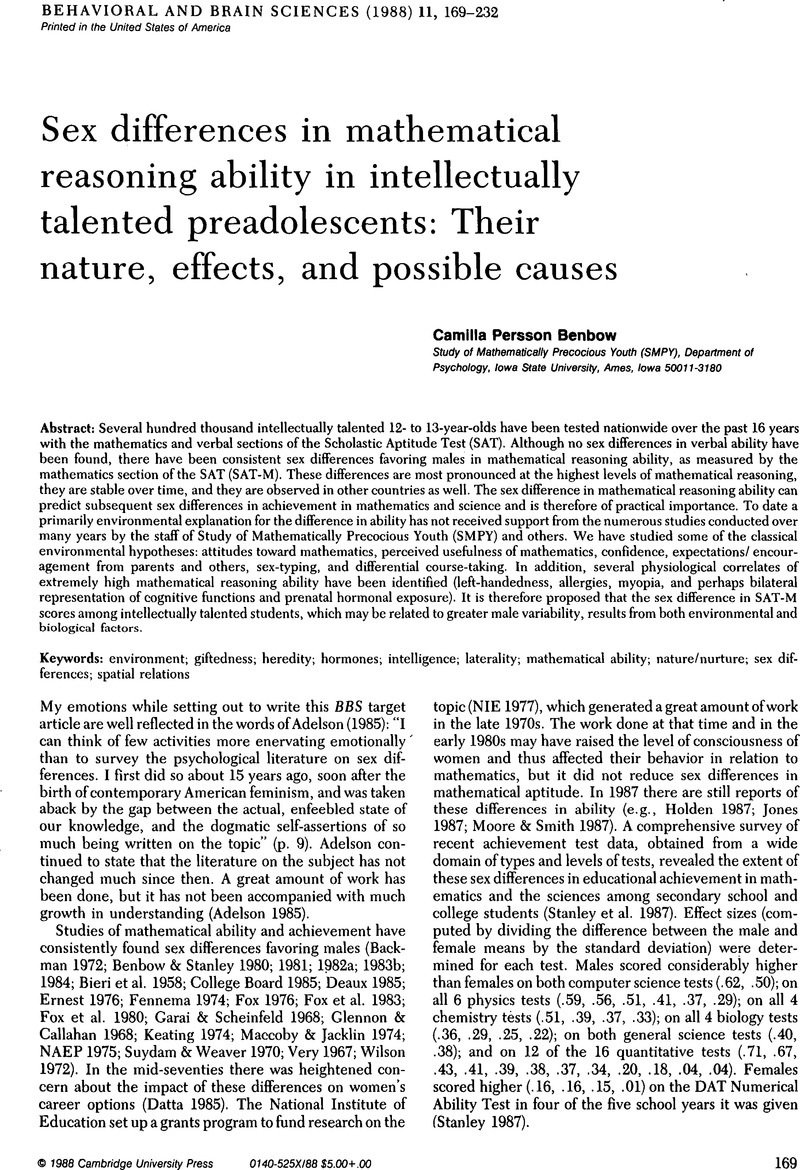Crossref Citations
This article has been cited by the following publications. This list is generated based on data provided by Crossref.
Lubinski, David
and
Humphreys, Lloyd G.
1990.
A broadly based analysis of mathematical giftedness.
Intelligence,
Vol. 14,
Issue. 3,
p.
327.
Feingold, Alan
1992.
Sex Differences in Variability in Intellectual Abilities: A New Look at an Old Controversy.
Review of Educational Research,
Vol. 62,
Issue. 1,
p.
61.
Lubinski, David
and
Humphreys, Lloyd G.
1992.
Some bodily and medical correlates of mathematical giftedness and commensurate levels of socioeconomic status.
Intelligence,
Vol. 16,
Issue. 1,
p.
99.
Hedges, Larry V.
and
Friedman, Lynn
1993.
Gender Differences in Variability in Intellectual Abilities: A Reanalysis of Feingold’s Results.
Review of Educational Research,
Vol. 63,
Issue. 1,
p.
94.
Thomas, Hoben
1993.
A theory explaining sex differences in high mathematical ability has been around for some time.
Behavioral and Brain Sciences,
Vol. 16,
Issue. 1,
p.
187.
Witt, Elizabeth A.
Dunbar, Stephen B.
and
Hoover, H.D.
1994.
A Multivariate Perspective on Sex Differences in Achievement and Later Performance Among Adolescents.
Applied Measurement in Education,
Vol. 7,
Issue. 3,
p.
241.
Stumpf, Heinrich
and
Jackson, Douglas N.
1994.
Gender-related differences in cognitive abilities: Evidence from a medical school admissions testing program.
Personality and Individual Differences,
Vol. 17,
Issue. 3,
p.
335.
Stumpf, Heinrich
1995.
Gender differences in performance on tests of cognitive abilities: Experimental design issues and empirical results.
Learning and Individual Differences,
Vol. 7,
Issue. 4,
p.
275.
Stumpf, Heinrich
and
Eliot, John
1995.
Gender-related differences in spatial ability and the k factor of general spatial ability in a population of academically talented students.
Personality and Individual Differences,
Vol. 19,
Issue. 1,
p.
33.
Charness, Neil
and
Gerchak, Yigal
1996.
Participation Rates and Maximal Performance: A Log-Linear Explanation for Group Differences, Such as Russian and Male Dominance in Chess.
Psychological Science,
Vol. 7,
Issue. 1,
p.
46.
Frith, Uta
and
Happé, Francesca
1996.
Mary has more: Sex differences, autism, coherence, and theory of mind.
Behavioral and Brain Sciences,
Vol. 19,
Issue. 2,
p.
253.
Chipman, Susan F.
1996.
Still far too sexy a topic.
Behavioral and Brain Sciences,
Vol. 19,
Issue. 2,
p.
248.
Feingold, Alan
1996.
On an evolutionary model of sex differences in mathematics: Do the data support the theory?.
Behavioral and Brain Sciences,
Vol. 19,
Issue. 2,
p.
252.
Casey, M. Beth
1996.
Do gender differences in spatial skills mediate gender differences in mathematics among high-ability students?.
Behavioral and Brain Sciences,
Vol. 19,
Issue. 2,
p.
247.
Humphreys, Lloyd G.
1996.
A critic with a different perspective.
Behavioral and Brain Sciences,
Vol. 19,
Issue. 2,
p.
257.
Stanley, Julian C.
and
Stumpf, Heinrich
1996.
Able youths and achievement tests.
Behavioral and Brain Sciences,
Vol. 19,
Issue. 2,
p.
263.
Kimball, Meredith M.
1996.
Some problematic links between hunting and geometry.
Behavioral and Brain Sciences,
Vol. 19,
Issue. 2,
p.
258.
Thomas, Hoben
1996.
Between-sex differences are often averaging artifacts.
Behavioral and Brain Sciences,
Vol. 19,
Issue. 2,
p.
265.
Geary, David C.
1996.
On the biology and politics of cognitive sex differences.
Behavioral and Brain Sciences,
Vol. 19,
Issue. 2,
p.
267.
Geary, David C.
1996.
Sexual selection and sex differences in mathematical abilities.
Behavioral and Brain Sciences,
Vol. 19,
Issue. 2,
p.
229.



